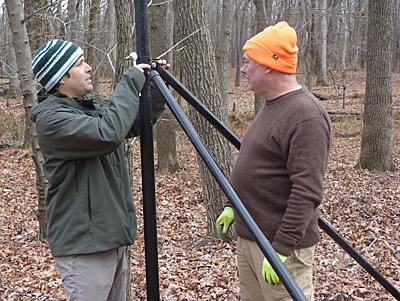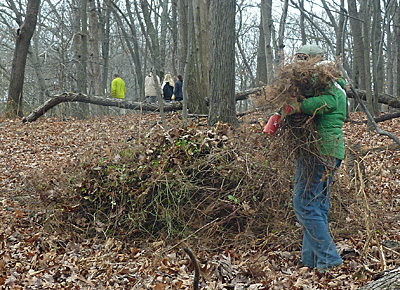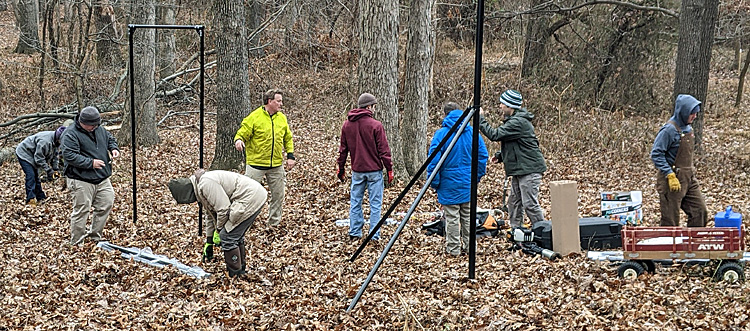
Working on the corner post.
Photo by SA Ferguson
On December 10, 15 volunteers, including two high school students, met at JK Black Oak Wildlife Sanctuary for the monthly work day led by Gerco Hoogeweg. Unlike the November work day when we had unseasonably warm weather, this one was much colder, and we were treated to a couple of sleet showers. However, the weather did not deter us, and we kept working on installing the deer exclusion fence.
This work day was the second habitat restoration project at JK Black Oak funded by a generous grant from Microsoft. The grant enables Loudoun Wildlife to buy the required materials to build three deer exclusion fences and protect over 100 trees from deer with metal cages. The first project was building a deer exclosure that was 25 by 25 feet. We used the lessons learned from the first exclosure to scale up and install a second deer exclosure measuring 50 by 50 feet. When we installed the first deer fence, we had issues getting the motorized post pounder to hammer metal post sleeves into the very hard ground. This time we used a narrow auger to drill pilot holes into the ground, which made it very easy to drill the sleeves into the ground and install the posts. The heavy-duty corner posts with cross braces required manual labor, using a soil auger and a posthole digger.

Piling up invasives.
Photo by SA Ferguson
While holes were being drilled and the posts installed, several volunteers began the removal of invasive species including Japanese Honeysuckle and Oriental Bittersweet. Although we had a healthy population of both species within the deer exclusion area, the volunteers made quick work of pulling them out and piling them up into a small brush pile. Removing invasives will be one of the ongoing maintenance tasks we will need to stay on top of both inside and outside the exclusion fences. The exclusion fences are being put in place to see what native plants, including shrubs and trees, will grow now that they are protected from deer.
Several dead trees had been cut down before the work day to prevent them from falling on the fence. One volunteer cleared the leaves from under the logs to provide better contact with the ground and keep soil under the logs moist. These downed trees will provide habitat for many species including frogs, salamanders and snakes.
Once the posts were installed, it was time to install the tension wire from which we could hang the fencing. It was at that moment we realized that we did not have enough tools with us. Using a single ladder, a single crimping tool and one D-ringer definitely caused a bit of a delay in finishing up the fence installation. Trying to hang up 50 foot sections of fence is also a challenge. So we learned a couple valuable lessons here such as bringing more tools, using smaller fence sections, and ensuring that your corner posts are securely in the ground. We discovered that last one when tightening the tension on the wires pulled one corner post out of the ground — that was unexpected. After nearly five hours of work, the second deer exclusion fence was installed. Our third, and final, deer exclusion fence will be installed during the April and May, 2023 work days. This fence will be considerably larger and will protect the catchment of a vernal pool from deer browsing.
To protect the environmentally sensitive habitat and rare species, JK Black Oak Wildlife Sanctuary is not open for general public access.

Photo by Allison Gallo

